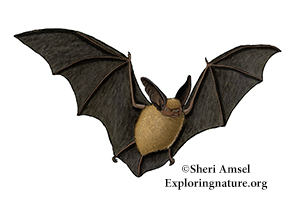

They are found from southwestern Canada south through the western U.S. down into Mexico.
Although they live in all forest types, they seem to prefer coniferous forest.
Their fur is yellow to light brown. They have dark wings and ears. They are up to 4” long with 11” wide wings. They have big ears reaching up to almost an inch long and believed to be the longest of any bat in the U.S. There is a flap of skin that stretched between the legs and tail called the uropatagium.
They are nocturnal, coming out to hunt at night using echolocation. Echolocation is a kind of radar that uses the bat’s high-pitched calls to bounce off objects. They can actually “see” what is around them by how their calls bounce off their surroundings. They roost during the day in trees, caves, barns and farm outbuilding.
They eat insects – mainly moths.
Roosting in the forest by day, they can be preyed upon by animals that smell the build up of bat guano (waste) under where they sleep.
Though rarely witnessed, it is thought that like most U. S. bats they mate in the fall and females storing the sperm until spring. Once pregnant females carry their young for up to 2 months and give birth in late spring to early summer. They feed them milk until the babies begin to fly and can chase insects for themselves.
They live less than 10 years in the wild, but banded bats have been known in rare cases to live past 20 years. They are not a threatened species.
Kingdom: Animalia
Phylum: Chordata
Subphylum: Vertebrata
Class: Mammalia
Order: Chiroptera
Family: Vespertilionidae
Subfamily: Myotinae
Genus: Myotis
Species: Myotis evotis
When you research information you must cite the reference. Citing for websites is different from citing from books, magazines and periodicals. The style of citing shown here is from the MLA Style Citations (Modern Language Association).
When citing a WEBSITE the general format is as follows.
Author Last Name, First Name(s). "Title: Subtitle of Part of Web Page, if appropriate." Title: Subtitle: Section of Page if appropriate. Sponsoring/Publishing Agency, If Given. Additional significant descriptive information. Date of Electronic Publication or other Date, such as Last Updated. Day Month Year of access < URL >.
Amsel, Sheri. "Bat (Western Long-eared Myotis) " Exploring Nature Educational Resource ©2005-2024. December 13, 2024
< http://www.exploringnature.org/db/view/Western-Long-eared-Myotis-bat >

